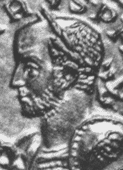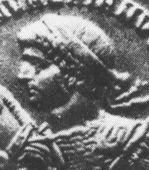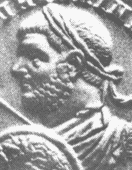|


|
Buon Natale
e Buon Anno
Nuovo
a tutti i
nostri lettori!
from the Italian
Club and the staff of
La Rondine
|
JANUARY MEETING
ANNALES FOR 2002
|
| The format of our January meeting never varies.
It is our one “business” type meeting of the year. The comprehensive
report of our Club’s performance over the preceding year is presented followed
by an open discussion of how performance can be improved. Traditionally,
we call this our Annales meeting named after the ancient Roman practice
in which the Pontiffs, the priests of the State religion, were required
to make a formal report (inscribed on bronze tablets) to the Senate and
the people of Rome of events of major importance throughout the Empire
which had occurred during the previous year.
But while we believe it is important to look back at what
we have done, we also believe, like Janus, that it is equally important
to look ahead and plan for the future.
The January meeting will include a brief ceremony to install our new
Officers and Director and to vote on new member applications. We
will then proceed to the reports by various Board Members on the Club’s
financial 2002 performance and status, membership, member survey results,
programs and activities, the Club’s involvement with the Federation of
Italian American Organizations (FIAO) and discussion on any and all issues
that members believe are of importance to our Club.
|
|
Next Meeting Wednesday, January 15, 2003
Cocktails 6:30 PM - Dinner 7:00 PM
Da Baldo's Restaurant
RSVP Marie Wehrle
(314) 544-8899
or by email
|

RECAP OF OCTOBER
MEETING
| ARTIST BILL KOHN |
Our November speaker, Artist Bill Kohn, focused
his multi-media presentation on a selection of paintings of the dome of
the Church of Santa Maria della Fiore, the Cathedral of Florence, taken
from his recent and highly-praised series of water-color and acrylic works
entitled Brunelleschi ed io – New Paintings of the Florence Duomo.
Kohn’s Brunelleschi’s Dome series paintings were recently exhibited in
a tremendously successful show at the Elliot Smith Gallery of Contemporary
Art.
But Kohn’s Italian Club presentation was not limited to
showing and describing his paintings of the Duomo of Florence; his program
was much more complex and comprehensive. The heart of the presentation
was a multi-media retrospective sampling of Kohn’s entire artistic career.
Included in the presentation were samples of other works currently being
shown in another exhibition entitled Places of Power. Bill Kohn:
A Forty-Year Retrospective – 1962 to 2002. This exhibition, at
the Des Lee Gallery, 1627 Washington Avenue through Jan 2, 2003, offers
a comprehensive look at Kohn’s life-long artistic career. Also included
in Kohn’s presentation, was a 7-minute selection from a music-video composition
called Brunelleschi e noi that presents sounds and music of
Florence combined with interior and exterior views of the cathedral and
its great cupola.
The Brunelleschi e noi work is one segment
of a new collaborative music-video DVD entitled Locations 1970 – 2002:
The Collaborative Works of Bill Kohn, which provides a comprehensive
panorama of Kohn’s evolution as an artist over time and distance.
Created by Kohn in collaboration with composer Rich O’Donnell, photographer
Dale Dufer, and filmmaker Debbie Lum, this DVD includes the following segments:
Locations (1970); Pilgrimage to the Virgin of Rocio (1986);
Rim to River/Bright Angel (1990); Machu Picchu/Sacred Light (1997);
Undulations (1997); Places of Power (1999); and Brunelleschi
e noi (2002). The segment, Places of Power: The art of Bill
Kohn is of particular interest and in itself worth the price of the
limited-edition DVD, because in this segment, filmed primarily in Kohn’s
studio, the artist discusses his thinking about his life and his work (…I
paint because I don’t know the answers).
Bill Kohn has had a long and distinguished career as a
painter and teacher. Born in St. Louis, he grew up in the Central
West End and graduated from the Washington University School of Art.
He has been a member of the WU faculty since 1963 and is now an Emeritus
Professor of Art. Much has been written about Bill Kohn and his works.
Most recently, two articles have appeared in the local press: Destination:
Inspiration, by Post Dispatch architecture critic Robert Duffy, in
the October 27, 2002 issue of the Post; and Everything is Illuminated,
by Timothy Hand, in the Nov 27-Dec 3, 2002 issue of the West End Word.
Kohn’s life-long search for artistic meaning has taken him all over the
world – but he is always glad to be back to St. Louis. Currently
busy remodeling his CWE studio and planning his next project – he still
finds time and energy, at age 71, to make 10-mile bicycle rides.
|
|

RECAP OF OUR
80TH ANNIVERSARY CELEBRATION
| On Sunday, December 8th, the Italian Club of St. Louis
celebrated its 80th anniversary with a special dinner dance at the Westborough
Country Club attended by 163 members and friends. Italian Club President-Elect
James Tognoni acted as Master of Ceremonies. The Rev. Monsignor Salvatore
Polizzi gave the opening invocation. Guest of Honor was Joe Garagiola,
well-known sports and television celebrity, who was introduced by Joseph
Colagiovanni, Honorary Vice-Consul of Italy. In recognition of Mr.
Garagiola’s many contributions to charitable causes and in appreciation
of the positive image of Italian-Americans which he has made throughout
his life, the Italian Club presented Joe Garagiola with a specially cast
bronze figure of the famous statue, The Italian Immigrants, by sculptor
Rudolph Torrini. In addition, the Club presented Garagiola with a
donation for the charity of his choice. At the conclusion of the
formal program, Peter Puleo, speaking on behalf of the Board of Directors,
announced that, in celebration of its 80th birthday, the Italian Club had
established an annual scholarship in Italian language studies at Saint
Louis University to be named after the retiring President of the Club,
Eugene Mariani. The Rev. Monsignor Jasper Chiodini then delivered
the closing benediction.
Such are the basic facts describing our 80th anniversary
party. But facts alone fall short of adequately expressing the nature
and spirit of what was truly a very different and special evening.
Of course, our Club’s 80th birthday was recognized with the elegance and
approbation appropriate for such an important event in our history.
But what made the evening really special was the presence of the popular
Garagiola and the out-pouring of warmth, love, affection, and emotion bestowed
on him by the many old friends who knew and grew up with him in the “Hill
neighborhood” and who came to be with him on this occasion. The love
that Garagiola feels for his Italian heritage, for the Hill, and for his
old friends was made eminently clear by his talk which emphasized the importance
of culture, neighborhood, and people in the formation of values and character.
His presentation stressed that it was this culture and upbringing that
was so important in forming the characters of the sons and daughters of
countless Italian immigrants who, despite the prejudice, hardship, and
tremendous difficulties which they, and especially their parents, had to
endure, were able to succeed and lead exemplary lives of positive contribution
to the entire society of the nation. Clearly, Garagiola was deeply
moved by the surprise gift of the statue of the Italian Immigrants made
at the conclusion of his remarks. Interestingly, Torrini’s great
work clearly symbolized precisely the values expressed in Garagiola’s presentation.
Upon being presented the Club’s financial contribution
to be given to an organization of his choice, Garagiola handed it back,
saying: “I want you to give $1000 of this to the Hill 2000 Sick and Elderly
Fund. Keep the rest to help continue the work of the Italian Club”.
Many thanks, Joe. And, of course, heartfelt thanks as well to all
members, friends, and patrons whose participation and generous support
made our 80th anniversary celebration a great success.
|

|
ANNOUNCEMENTS
CONDOLENCES
|
On behalf of the Italian Club, we wish to extend our sympathy
and condolences to long time member and friend Cav. Valerio Bianco,
and to his son Robert, on the death of Valerio’s wife, Eleanor,
on December 3, 2002.
|
|

CONGRATULATIONS
|
Congratulations to member Bart Saracino on his recent election
to the Missouri Restaurant Association Hall of Fame.
|
|

ITALIAN CLASSES AT SHAW COMMUNITY
SCHOOL
|
| Evening classes for adults at various levels will commence
during the week of January 27, 2003 at the Shaw Community School located
at Macklind and Columbia Avenues in the Hill neighborhood. Classes
for children will commence during the week of February 1, 2003 and will
be held on Saturday mornings at the nearby Southwest Bank located at the
corner of Kingshighway and Southwest Avenues.
An Open House/Information/Registration Session will be
held on Tuesday evening, January 21, 2003, at the Shaw School. Refreshments
at 6:30 PM. A presentations about the program will be held between
7:00 and 8:00 PM. This is a great opportunity to learn abut the various
courses, meet the teachers, and discuss your specific language goals with
them, as well as to register and, for new students, to purchase text and
work books.
The Shaw Language Program classes are excellent – with
experienced, dedicated, and enthusiastic teachers – and tuition is very
reasonable. For more information contact Gene Mariani at 314-352-5484
or by email at emariani@aol.com. |
|

The Italian Club of St. Louis
|
|
|
|


| I capolavori della poesia italiana
Alfonso Gatto (Salerno, 1909 – Orbetello 1976) ebbe una giovinezza
movimentata e più tardi esercitò la professione di giornalista.
La poesia A mio padre fa parte della raccolta intitolata Il capo sulla
neve, che fu poi inserita nel volume di poesie della resistenza.
Benché di solito sia identificato con la poesia di tipo ermetico,
qui il poeta evoca la figura del padre senza ricorrere a questo stile,
evocando un’immagine sospesa tra ricordo e fantasia.
A mio padre
di Alfonso Gatto
Se mi tornassi questa sera accanto
lungo la via dove scende l’ombra
azzurra già che sembra primavera,
per dirti quanto è buio il mondo e come
ai nostri sogni in libertà s’accenda
di speranze di poveri di cielo,
io troverei un pianto da bambino
e gli occhi aperti di sorriso, neri
neri come le rondini del mare.
Mi basterebbe che tu fossi vivo,
un uomo vivo col tuo cuore è un sogno.
Ora alla terra è un’ombra la memoria
della tua voce che diceva ai figli:
“Com’è bella la notte e com’è buona
ad amarci così con l’aria in piena
fin dentro al sonno”. Tu vedevi il mondo
nel plenilunio sporgere a quel cielo,
gli uomini incamminati verso l’alba.
|
|

| (Continua dal numero precedente)
Marco Aurelio Caro 224-283 (Imperatore 282-283)
M. Aurelio Numeriano 253-284 (Imperatore 283-284)
M. Aurelio Carino 250-285 (Imperatore 283-285)
 Alla morte di
Probo le legioni acclamarono imperatore M. Aurelio Caro, il prefetto
del pretorio. Caro non si curò neppure di chiedere l’approvazione
del Senato, limitandosi semplicemente a notificarlo a elezione avvenuta.
Prima ancora di andare a Roma, Caro si diede da fare per stabilire la sua
dinastia e diede il titolo di Cesare ai suoi due figli, Carino e
Numeriano. Alla morte di
Probo le legioni acclamarono imperatore M. Aurelio Caro, il prefetto
del pretorio. Caro non si curò neppure di chiedere l’approvazione
del Senato, limitandosi semplicemente a notificarlo a elezione avvenuta.
Prima ancora di andare a Roma, Caro si diede da fare per stabilire la sua
dinastia e diede il titolo di Cesare ai suoi due figli, Carino e
Numeriano.
Ben presto l'impero vide di nuovo le frontiere assalite dai nemici:
i Franchi sul Reno; gli Alemanni, i Quadi e i Sarmati sul Danubio; i Persiani
sull'Eufrate. Insieme al figlio Numeriano, Caro si recò in
Oriente, lasciando il comando dell’impero occidentale al figlio Carino,
e nel 283 invase la Mesopotamia e sconfisse i Persiani. A Roma, per
celebrare questa vittoria, Carino fu dichiarato imperatore dell’impero
d’occidente.
Approfittando della debolezza dei Persiani, in declino fin dalla morte
del loro re Shapur, Caro stava preparandosi a muovere il suo esercito verso
l’interno della Persia quando fu trovato morto nella sua tenda a Ctesifonte,
forse vittima di un fulmine o forse avvelenato. Aveva regnato meno
di un anno.
 Numeriano,
proclamato dall’esercito come suo successore, con il consenso dell’esercito
decise di tornare a Roma. Numeriano era più un intellettuale
che un guerriero ed aveva anche scritto poesie ben note negli ambienti
romani. Inoltre soffriva di una malattia agli occhi che lo aveva
reso quasi cieco, tantoché doveva essere portato in una lettiga. Numeriano,
proclamato dall’esercito come suo successore, con il consenso dell’esercito
decise di tornare a Roma. Numeriano era più un intellettuale
che un guerriero ed aveva anche scritto poesie ben note negli ambienti
romani. Inoltre soffriva di una malattia agli occhi che lo aveva
reso quasi cieco, tantoché doveva essere portato in una lettiga.
Guidava l'esercito Arrio Apro, prefetto del pretorio e suocero
di Numeriano. Apro aveva dato l’ordine di non aprire la lettiga per
nessun motivo e ai soldati fu detto che l’imperatore era troppo malato
per apparire in pubblico. Ma nei pressi di Nicomedia i portantini
cominciarono a sentire un forte fetore. La lettiga fu aperta e Numeriano
fu trovato morto.
Apro, che forse sperava di essere acclamato imperatore, venne subito
sospettato dalle truppe come l’autore del delitto. Al suo posto l’esercito
elesse imperatore Valerio Diocle, il comandante della guardia del
corpo. In nome dell’esercito romano Diocle accusò Arrio Apro
di regicidio e lo trafisse con la spada. Era il 17 novembre dell'
anno 284.
 Alla notizia
della morte del fratello e della proclamazione di Diocle, Carino
mosse il suo esercito contro il rivale. Nella valle del Margus venne
a battaglia con Diocle e pare che stesse per vincere quando all'improvviso
cadde pugnalato da uno dei suoi tribuni (a cui pare avesse sedotto la moglie). Alla notizia
della morte del fratello e della proclamazione di Diocle, Carino
mosse il suo esercito contro il rivale. Nella valle del Margus venne
a battaglia con Diocle e pare che stesse per vincere quando all'improvviso
cadde pugnalato da uno dei suoi tribuni (a cui pare avesse sedotto la moglie).
Alla sua morte anche l'esercito di Carino riconobbe Diocle come imperatore.
(continua al prossimo numero)
Ed Note: The entire series, to date, can
be viewed on this Portal at La Storia
d'Italia |

|
|